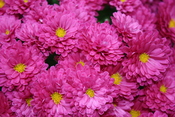Symbolism in John Steinbeck's "The Chrysanthemums"
In the short story, "The Chrysanthemums," Steinbeck effectively uses symbols to help the reader understand the story's plot and obtain insight into characters' thoughts and feelings, primarily Elisa. As the story's main character, Elisa is a lonely thirty-five-year-old woman, who serves as the channel in which most of these symbols are used.
Elisa feels neglected by her husband, Henry, who is always working cattle on their foothill ranch. He shows her little affection and attention, which causes her to become a very strong and determined looking woman: "Her face was lean and strong and her eyes were as clear as water. Her figure looked blocked and heavy in her gardening costume, a man's black hat pulled low down over her eyes" . This strong look serves as a barrier to her inner feelings of insecurity. Elisa turns to cherish and nurture the chrysanthemums, a symbol of her true beauty, as a result of her strained marriage.
Henry further separates himself from Elisa and her love of the chrysanthemums by saying, "I wish you'd work out in the orchard and raise some apples that big" (p. 247).
The story's narrator describes Elisa's flower garden nearly as a cage: "wire fence that protected her flower garden from cattle and dogs and chickens" (p. 247). This symbolizes the love Elisa has for the flowers by wanting to protect them. It also suggests to the reader that nothing will destroy her true beauty and feeling of self-worth, of which the flowers actually represent. The garden serves as a safe-haven for Elisa, in that no harm will come to her or her feelings while working it.
The appearance of the handyman in the story serves as a confidence booster for Elisa. It reinforces the...



Symbolism etc.etc.etc.
think you did a great job - logically set out and well written. Wish i could give more insight but i haven't actually read the book!
1 out of 1 people found this comment useful.